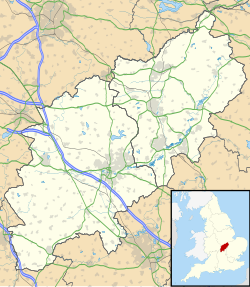| Mears Ashby | |
|---|---|
 | |
Location within Northamptonshire | |
| Population | 473 (2011 census) |
| OS grid reference | SP838666 |
| Unitary authority | |
| Ceremonial county | |
| Region | |
| Country | England |
| Sovereign state | United Kingdom |
| Post town | NORTHAMPTON |
| Postcode district | NN6 |
| Dialling code | 01604 |
| Police | Northamptonshire |
| Fire | Northamptonshire |
| Ambulance | East Midlands |
| UK Parliament | |
Mears Ashby is a village in the county of Northamptonshire, England. [1] It lies between the county town of Northampton and Wellingborough and was in the West ward of borough council of Wellingborough area which also included Sywell prior to local government reform in 2021. At the time of the 2011 census, it had a population of 473. [2]
Contents
The villages name means 'Ash-tree farm/settlement' or perhaps, 'Aski's farm/settlement'. The village was held by Robert de Mares in 1242. [3]

